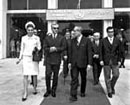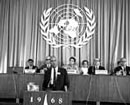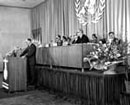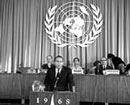|
Proclamation of Teheran
Teheran, 13 May 1968
Par Djamchid Momtaz
Professeur à l’Université de Téhéran Ancien président de la Commission du droit international
Les représentants des cent-vingt Etats participant à la première Conférence internationale des droits de l'homme, réunis à Téhéran du 22 avril au 13 mai 1968 sur l’invitation de l’Assemblée générale des Nations Unies (résolution 2081 (XX) de l’Assemblée générale du 20 décembre 1965), adoptaient par consensus, à l’issue de leurs travaux, la Proclamation de Téhéran. Elle sera annexée à l’Acte final de la Conférence (A/CONF./32/41) et approuvée la même année par l’Assemblée générale des Nations Unies (résolution 2442 (XXIII) de l’Assemblée générale du 19 décembre 1968). La Proclamation de Téhéran évalue les progrès réalisés depuis l’adoption de la Déclaration universelle des droits de l'homme le 10 décembre 1948 et établit un plan d’action pour le futur. La Proclamation déclare d’emblée que ladite Déclaration « constitue une obligation pour les membres de la communauté internationale » (§ 2), sans toutefois mettre un terme à la controverse sur sa nature juridique. Cette prise de position renforce incontestablement le front de ceux qui considéraient à l’époque qu’elle constituait une interprétation authentique des dispositions de la Charte relatives aux droits de l'homme. Il semble que les rédacteurs de la Proclamation aient été sensibles à la position adoptée à cet égard quelques mois plus tôt par un groupe d’experts réunis à l’initiative de Louis Bruno Sohn à Montréal (Montreal Statement of the Assembly of Human Rights, 27 March 1968). La « Déclaration sur l’octroi de l’indépendance aux pays et aux peuples coloniaux » (résolution 1514 (XV) de l’Assemblée générale du 14 décembre 1960) reçoit un traitement identique, la Proclamation considérant que les nations devront s’y « conformer » (§ 3). Tout en reconnaissant que, depuis l’adoption de la Déclaration, d’importants progrès ont été accomplis dans la définition de normes relatives à la jouissance des droits de l'homme et à leur protection, la Proclamation reconnaît qu’il reste beaucoup à faire pour assurer le respect effectif de ces droits. Deux domaines retiennent particulièrement l’attention: l’éradication de l’apartheid et la décolonisation (§ 7 et § 9). La Proclamation semble accorder une importance plus grande à la lutte contre l’apartheid, qu’elle qualifie de crime contre l’humanité, suivant en cela la position adoptée deux ans plus tôt par l’Assemblée générale (résolution 2202 A (XXI) de l’Assemblée générale du 16 décembre 1966). Elle tient d’ailleurs à préciser que « la lutte contre l’apartheid est reconnue comme légitime » (§ 7). On ne sait pas exactement ce que cette expression signifie vraiment. A défaut de pouvoir l’interpréter comme pouvant justifier un éventuel recours à la force armée, elle doit être considérée comme apportant un soutien aux diverses actions menées par les organes des Nations Unies dans le cadre de la lutte contre l’apartheid. Curieusement, concernant le refus des puissances coloniales de permettre aux peuples autochtones d’exercer leur droit à l’autodétermination et la lutte consécutive destinée à mettre fin à cette politique, la Proclamation est en retrait par rapport aux positions adoptées par l’Assemblée générale. Elle refuse en effet de qualifier, à l’instar de cet organe, la violation des droits politiques et économiques des peuples colonisés de crime contre l’humanité (résolution 2184 (XXI) de l’Assemblée générale du 12 décembre 1966). De même, alors que l’Assemblée générale avait reconnu la « légitimité de la lutte des peuples sous domination coloniale » (résolution 2105 (XX) de l’Assemblée générale du 20 décembre 1965), la Proclamation passe sous silence cette question. Le sous-développement économique est considéré, au même titre que les mesures discriminatoires fondées sur la race, la religion ou la croyance, comme constituant un obstacle au respect effectif des droits de l'homme (§ 11 et § 12). La question des fondements économiques des droits de l'homme a été un sujet de préoccupation de la Conférence de Téhéran. L’étude qui lui a été consacrée (A/CONF./32/2) a servi de base à l’adoption par cette Conférence de la résolution XVII intitulée « le développement économique et les droits de l'homme ». L’idée centrale de cette résolution, à savoir l’indivisibilité des droits de l'homme et l’impossibilité de la jouissance complète des droits civils et politiques sans la réalisation des droits économiques, sociaux et culturels, a été reprise par la Proclamation de Téhéran (§ 13). La question de l’indivisibilité des droits de l'homme et de la priorité accordée par les Etats les plus démunis au droit au développement, considérée comme étant le reflet de la division idéologique nord-sud, reste controversée et est considérée par ses opposants comme une entrave au développement des droits de l'homme. Le plan d’action envisagé par la Proclamation de Téhéran pour le futur accorde une place de choix à la protection des personnes les plus vulnérables, plus particulièrement les analphabètes et les femmes. La Proclamation considère l’existence de plus de 700 millions d’illettrés dans le monde comme un « obstacle énorme » à tous les efforts accomplis pour la réalisation des objectifs de la Charte des Nations Unies et des dispositions de la Déclaration universelle. Elle demande que soit envisagée d’urgence une action internationale pour l’élimination de ce fléau (§ 14), question d’actualité à laquelle la communauté internationale n’a pu, à ce jour, apporter de réponse adéquate. Deux paragraphes de la Proclamation sont consacrés aux droits de la femme. L’un concerne la discrimination dont les femmes sont encore victimes. La Proclamation considère que le maintien de la femme dans une situation d’infériorité est contraire à la Charte et à la Déclaration universelle (§ 15). Ce qui constitue incontestablement une première est la reconnaissance du droit fondamental des parents de « déterminer librement et sciemment la dimension de leur famille et l’échelonnement des naissances » (§ 16), assertion qui reconnaît implicitement à la femme le droit d’interrompre une éventuelle grossesse et sur laquelle sont fondées les politiques nationales de planning familial. La Proclamation de Téhéran annonce enfin l’émergence des droits de l’homme de la troisième génération, qualifiés plus tard de droits de solidarité. Il s’agit plus particulièrement du droit à la paix. La Proclamation considère que l’agression et les conflits armés entrainant le déni massif des droits de l'homme, il incombe à la communauté internationale de coopérer pour éliminer ces fléaux (§ 10). C’est dans ce contexte qu’il faut situer l’affirmation de la Proclamation selon laquelle les progrès scientifiques et techniques peuvent mettre en danger les droits et libertés de l’individu (§18). Les expériences des deux guerres mondiales ont en effet montré que de telles découvertes ont aussi servi à mettre au point des armes dont les effets destructeurs ont été immenses. C’est ainsi que la Proclamation de Téhéran a été amenée à considérer que « le désarmement général et complet est l’une des plus hautes aspirations de tous les peuples ». Les ressources humaines et matérielles consacrées aux fins militaires pourraient ainsi être mises au service des droits de l’homme et des libertés fondamentales (§ 19). Malgré ses nombreuses avancées, la Proclamation de Téhéran n’a guère suscité d’intérêt auprès des instances onusiennes. L’Assemblée générale des Nations Unies ne s’y est jamais référée, à l’exception peut-être de sa résolution relative au sort des personnes qui refusent de servir dans les forces militaires ou policières utilisées pour faire appliquer l’apartheid (résolution 33/165 de l’Assemble générale du 20 décembre 1978). Pour ce qui est des organes de suivi des droits de l'homme, il semblerait que seule la Sous-Commission de la lutte contre les mesures discriminatoires et de la protection des minorités puisse être citée. Celle-ci s’est en effet fondée sur cette Proclamation pour condamner l’Ordonnance du 28 avril 1984 des autorités pakistanaises qualifiant les activités des membres de la communauté Ahmadi d’apostasie. Pour la Sous-Commission, cette décision constitue une violation flagrante de la liberté de conscience et de religion (résolution 1985/21 de la Sous-Commission de la lutte contre les mesures discriminatoires et de la protection des minorités du 29 août 1985, E/CN.4/1986/5) reconnue par la Proclamation de Téhéran (§ 5). This Introductory Note was written in August 2009.
Reférences bibliographiques A. Documents Résolution 1514 (XV) de l’Assemblée générale du 14 décembre 1960 (Déclaration sur l’octroi de l’indépendance aux pays et aux peuples coloniaux). Résolution 2081 (XX) de l’Assemblée générale du 20 décembre 1965 (Année internationale des droits de l’homme). Résolution 2105 (XX) de l’Assemblée générale du 20 décembre 1965 (Application de la Déclaration sur l’octroi de l’indépendance aux pays et aux peuples coloniaux). Résolution 2184 (XXI) de l’Assemblée générale du 12 décembre 1966 (Questions des territoires administrés par le Portugal). Résolution 2202 A (XXI) de l’Assemblée générale du 16 décembre 1966 (Politique d’apartheid du Gouvernement de la République sud-africaine). Résolution 2442 (XXIII) de l’Assemblée générale du 19 décembre 1968 (Conférence internationale des droits de l’homme). Résolution 33/165 de l’Assemble générale du 20 décembre 1978 (Statut des personnes qui refusent de servir dans des forces militaires ou policières utilisées pour faire appliquer l’apartheid). Résolution 1985/21 de la Sous-Commission de la lutte contre les mesures discriminatoires et de la protection des minorités du 29 août 1985 (La situation au Pakistan) (reproduit dans Rapport de la Sous-Commission de la lutte contre les mesures discriminatoires et de la protection des minorités sur les travaux de sa trente-huitième session, E/CN.4/1986/5). B. Doctrine United Nations Actions in the Field of Human Rights, New York, United Nations, 1974. René Cassin, « Droits de l’homme et méthode comparative », Revue de droit international comparé, vol. 20, 1968, pp. 449-492. Jo M. Pasqualucci, “Louis Sohn: Grandfather of International Human Rights Law in the United States”, Human Rights Quarterly, vol. 20, 1998, pp. 924-944.
On 10 September 1963, to commemorate the twentieth anniversary of the adoption and proclamation of the Universal Declaration of Human Rights, Jamaica requested that the item entitled “Designation of 1968 as International Year for Human Rights” be included in the agenda of the eighteenth session of the General Assembly (A/5493). At that session, on 20 September 1963, the General Assembly decided to include the item in its agenda and allocated the matter to its Third Committee (A/PV.1209). On 12 December 1963, following the recommendation of its Third Committee (A/5660), the General Assembly adopted resolution 1961 (XVIII) by which it designated 1968 as International Year for Human Rights. By the same resolution, the General Assembly further requested the Economic and Social Council to invite the Commission on Human Rights at its forthcoming sessions to: (i) prepare a programme of measures and activities representing a lasting contribution to the cause of human rights; (ii) prepare suggestions for a list of goals in the field of human rights to be achieved by the United Nations by the end of 1968; and (iii) submit the programme of measures and activities and the suggestions for the list of goals in time for consideration by the General Assembly at its twentieth session. On 17 December 1963, at its resumed thirty-sixth session, the Economic and Social Council transmitted resolution 1961 (XVIII) to the Commission on Human Rights which, in turn, considered the tasks entrusted to it under that resolution during its twentieth session in 1964.
The Committee on the International Year for Human Rights held a series of meetings in March 1965 and, in its lengthy discussions, paid a great deal of attention to the possibility of holding an international conference on human rights. The Committee, following the submission of a joint draft resolution by Costa Rica, Jamaica and the Philippines (E/CN.4/L.769), recommended that the Commission on Human Rights invite the General Assembly, through the Economic and Social Council, to convene an international conference on human rights during 1968 (see Report of the Committee, E/CN.4/886). At its twenty-first session, on 13 April 1965, the Commission on Human Rights adopted resolution 5 A (XXI), based, in substance, on that proposal (see Report of the Commission on the work of its twenty-first session, E/4024). On 28 July 1965, following the proposal of the Commission on Human Rights, the Economic and Social Council adopted resolution 1074 E (XXXIX) by which it recommended the General Assembly to convene an international conference on human rights during 1968 and requested the Commission on Human Rights, inter alia, to elaborate for its consideration the agenda of that conference (see Report of the Social Committee to the Economic and Social Council, E/4100). At the twentieth session of the General Assembly, resolution 1074 E (XXXIX) was transmitted to the Assembly, which, on 24 September 1965, allocated the matter to its Third Committee under an item of its agenda entitled “International Year for Human Rights” (A/PV.1336). During the debate in the Third Committee, a joint proposal (A/C.3/L.1318) was made to establish a Preparatory Committee consisting of Member States, entrusted with elaborating the agenda of the conference and making other proposals on practical matters related to its convening. On 13 December 1965, the Third Committee adopted, in substance, the joint proposal and recommended that the General Assembly adopt a resolution to this effect (A/6184). On 20 December 1965, the General Assembly adopted resolution 2081 (XX) by which it thus decided that an International Conference on Human Rights should be convened during 1968 to promote further the principles contained in the Universal Declaration of Human Rights, to develop and guarantee political, civil, economic, social and cultural rights and to end all discrimination and denial of human rights and fundamental freedoms on grounds of race, colour, sex, language or religion, and in particular to permit the elimination of apartheid. The specific tasks of the Conference were (i) to review the progress which had been made in the field of human rights since the adoption of the Universal Declaration; (ii) to evaluate the effectiveness of the methods and techniques used by the United Nations in the field of human rights; and (iii) to formulate and prepare a programme of further measures to be taken subsequent to the celebration of the International Year of Human Rights. The resolution further decided that a Preparatory Committee, consisting of 17 Member States, should be established in order to complete the preparation of the Conference and, in particular, to make proposals for the consideration of the General Assembly regarding the agenda and other practical matters. Finally, the resolution requested the Preparatory Committee to report on the progress of the preparation in order that such reports might be considered by the General Assembly at its twenty-first and twenty-second sessions. On 9 May 1966, the Preparatory Committee was convened by the Secretary-General and held a series of meetings in May and June of that year. At these meetings, the Committee approved a draft provisional agenda of the Conference, on the understanding that it might be added to or modified as its work continued at its next session (see First Progress Report of the Preparatory Committee, A/6354). The first progress report was transmitted to the General Assembly during its twenty-first session which, on 24 September 1966, allocated the matter to its Third Committee as part of the item of its agenda entitled “International Year for Human Rights” regarding the report relating to the Preparatory Committee (A/PV.1415). In addition to the first progress report, the Third Committee also had before it a communication of 18 October 1966, received by the Secretary-General from Iran (A/C.3/602), which extended an invitation to hold the Conference in Tehran during 1968. During the debate in the Third Committee, two joint draft resolutions (A/C.3/L.1425 and A/C.3/L.1435) which took note of the first progress report were submitted. These draft resolutions proposed in their operative parts that: (i) the Conference be held in Tehran during 1968; (ii) the membership of the Preparatory Committee be enlarged to 23 Member States; and (iii) the duly enlarged Preparatory Committee be requested to continue its work, taking into account such observations as it may receive from the Commission on Human Rights and from the Commission on the Status of Women, and to report further on the progress of the preparation of the Conference to the General Assembly at its twenty-second session. On 17 December 1966, in its report to the General Assembly (A/6619), the Third Committee recommended that the Assembly adopt a resolution based, in substance, on that proposal. On 19 December 1966, the General Assembly adopted resolutions 2217 C and D (XXI) to this effect. At its meetings in 1967, the Preparatory Committee resumed its consideration of the draft provisional agenda of the Conference and other practical matters related to its convening. The Preparatory Committee had before it a number of recommendations concerning possible items to include on the provisional agenda it had received from the Commission on Human Rights, the Commission on the Status of Women, as well as the Economic and Social Council. The Preparatory Committee, having taken note of those recommendations, as well as others, adopted a provisional agenda which was transmitted to the General Assembly for consideration at its twenty-second session (see First Report of the Committee, A/6670 and Corr.1, annex II). On 23 September 1967, the Assembly again allocated the matter to its Third Committee as part of the ongoing item of its agenda entitled “International Year for Human Rights” which related to the report of the Preparatory Committee (A/PV.1564). During the debate in the Third Committee, two joint draft resolutions were submitted (A/C.3/L.1501 and A/C.3/L.1501/Rev.1) which approved, in substance, the report of the Preparatory Committee, and accordingly proposed to take note of the provisional agenda for the International Conference on Human Rights elaborated by that body. On 16 December 1967, in its report to the General Assembly (A/7008), the Third Committee recommended that the Assembly adopt a resolution based on that proposal. On 18 December 1967, the General Assembly adopted resolution 2339 (XXII) to this effect and requested the Secretary-General to make certain practical arrangements related to the convening of the Conference. The International Conference on Human Rights met in Tehran, Iran, from 22 April to 13 May 1968 and was attended by representatives of 84 States and by representatives or observers from a number of United Nations bodies and specialized agencies, regional inter-governmental organizations and non-governmental organizations. The Conference largely adopted as its agenda the provisional agenda which had been drawn up by the Preparatory Committee, and of which the General Assembly had taken note in resolution 2339 (XXII), and established three Committees in order to deal with the substantive items on that agenda. On 13 May 1968, the Conference unanimously adopted the Proclamation of Tehran. In addition, the Conference adopted 29 resolutions, among which, resolutions on racial discrimination, self-determination and human rights in armed conflict. The texts of the Proclamation and of the resolutions adopted at the Conference were incorporated in the Final Act of the International Conference on Human Rights and transmitted to the General Assembly for further consideration (A/CONF.32/41). At its twenty-third session, on 27 September 1968, the General Assembly allocated the matter to its Third Committee under an item of its agenda entitled “International Year for Human Rights” which related to the International Conference on Human Rights (A/PV.1676). Following a debate in the Third Committee (A/C.3/23/SR.1620-1642), the Committee recommended that the General Assembly take note of the Final Act of the Conference and endorse the Proclamation of Tehran (A/7433). In addition, the Third Committee recommended that the General Assembly keep under review, insofar as possible, the resolutions of the Tehran Conference in connection with related agenda items and made specific proposals to adopt several resolutions agreed to at that Conference during the twenty-third session of the Assembly. On 19 December 1968, the General Assembly thus adopted by 115 votes to none, with 1 abstention, resolution 2442 (XXIII) to this effect. Text of the Proclamation Selected preparatory documents General Assembly, Note verbale from Jamaica to the Secretary-General (A/5493, 10 September 1963)
|
||||||||||||||||||||||||||||||||||||||||||||||||||||||||||||||||||||||||||||||||||||||||||||||||||||||||||||||||||||||||||||||||||||||||||||||||||||||||||||||||||||||||||||||||||||||||||||||

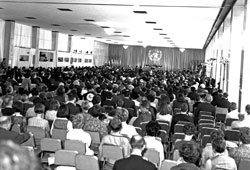 On 10 March 1964, during the debate on the matter in the Commission on Human Rights, Costa Rica introduced a draft resolution (E/CN.4/L.717) which, as revised three days later (E/CN.4/L.717/Rev.1), proposed to convene an international conference on human rights in 1968 and establish a Committee on the International Year for Human Rights composed of Member States. The Committee would be entrusted with meeting prior to the twenty-first session of the Commission on Human Rights in order to recommend a programme of measures and activities to be undertaken by Member States and the United Nations and its specialized agencies, in celebration of the twentieth anniversary of the Universal Declaration of Human Rights and in furtherance of human rights and fundamental freedoms. On 14 March 1964, the Commission on Human Rights adopted resolution 6 (XX) which was based, in substance, on the revised proposal by Costa Rica, and accordingly established a Committee composed of 34 Member States. The Committee was entrusted to give special thought to the possibility of holding an international conference in 1968 (see Report of the Commission on the work of its twentieth session, E/3873).
On 10 March 1964, during the debate on the matter in the Commission on Human Rights, Costa Rica introduced a draft resolution (E/CN.4/L.717) which, as revised three days later (E/CN.4/L.717/Rev.1), proposed to convene an international conference on human rights in 1968 and establish a Committee on the International Year for Human Rights composed of Member States. The Committee would be entrusted with meeting prior to the twenty-first session of the Commission on Human Rights in order to recommend a programme of measures and activities to be undertaken by Member States and the United Nations and its specialized agencies, in celebration of the twentieth anniversary of the Universal Declaration of Human Rights and in furtherance of human rights and fundamental freedoms. On 14 March 1964, the Commission on Human Rights adopted resolution 6 (XX) which was based, in substance, on the revised proposal by Costa Rica, and accordingly established a Committee composed of 34 Member States. The Committee was entrusted to give special thought to the possibility of holding an international conference in 1968 (see Report of the Commission on the work of its twentieth session, E/3873).








